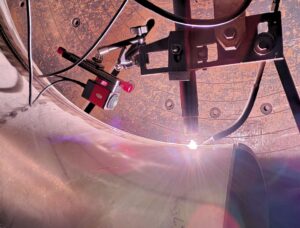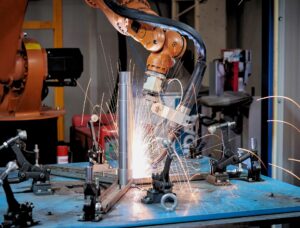The integration of robotics into welding processes has revolutionized manufacturing, offering significant advantages such as increased precision, speed, and consistency. Robotic welding is particularly valuable in industries like automotive, aerospace, and heavy fabrication, where high-quality welds are essential for product integrity. However, even with robotic systems, achieving flawless welds requires continuous monitoring and adjustments—this is where welding cameras come in. Welding cameras offer real-time feedback and allow for remote monitoring, making them an invaluable tool for enhancing the effectiveness of automated welding processes. Let’s explore welding cameras in robotics and how it help track and adjust robotic welding systems for optimal performance and superior weld quality.
1. Real-Time Monitoring for Precision and Quality Control
Automated welding robots can perform repetitive tasks with high speed and consistency, but maintaining precision across every weld requires constant oversight. Welding cameras are integrated into robotic welding systems to provide real-time visuals of the weld arc, weld pool, and heat distribution, ensuring that the welds meet the required standards.
How It Helps:
- Welding camera systems offer immediate visual feedback, allowing operators to see potential issues like misalignment or inconsistent bead formation
- Track the arc welding images to ensure consistent heat input and penetration across every weld
- Enable quick adjustments to the robot’s parameters, such as speed, amperage, and arc length, to maintain optimal weld quality
2. Enhanced Detection of Weld Defects – Welding Cameras in Robotics
One of the most significant advantages of using welding cameras in robotic systems is the ability to detect weld defects such as porosity, slag inclusion, and cracking in real time. With robotic welding, identifying these issues early on is crucial to avoiding costly rework or compromised product quality. Welding cameras enable operators to pinpoint these defects as they occur, allowing for immediate corrective actions.
Benefits:
- Detect weld defects early in the process, preventing them from becoming major issues
- Ensure the quality of welds in automated systems, even for complex geometries or tight tolerances
- Improve overall weld integrity and reduce the need for post-weld inspections or repairs
3. Optimizing Welding Parameters Through Camera Feedback
In robotic welding, maintaining the correct parameters—such as welding speed, amperage, and voltage—is essential for ensuring a strong, high-quality weld. Welding cameras provide continuous feedback that allows operators to adjust these settings in real time, ensuring that the robot is always operating within optimal conditions.
How It Helps:
- Continuously monitor the welding arc, making real-time adjustments to prevent overheating or under-heating the weld
- Use camera monitoring systems to fine-tune parameters like travel speed and wire feed rate for precise control
- Achieve perfect bead consistency, penetration, and uniform heat distribution with instant visual feedback
4. Improving Productivity and Reducing Downtime
The speed of robotic welding is one of its primary advantages. However, ensuring high-quality welds without constant rework requires maintaining consistent quality throughout the process. Welding cameras help minimize downtime by detecting problems early, allowing for quick corrections and reducing the need for manual inspections or adjustments during production.
Efficiency Gains:
- Use automated monitoring to track multiple welding robots at once, reducing the need for human intervention
- Detect problems in real-time, preventing production delays due to missed defects or incorrect settings
- Increase overall productivity by automating the quality control process and reducing the frequency of stoppages for manual inspections
5. Remote Monitoring for Better Control in Complex Environments
In environments where robotic welding systems work in confined spaces or on large workpieces, direct access to the welding arc can be challenging. Welding cameras provide remote monitoring capabilities, allowing operators to track the welding process from a safe distance without compromising visibility or control.
How It Helps:
- Monitor the welding process remotely using welding visual inspection techniques
- Gain real-time insights into the weld quality without physically being near the welding area
- Improve safety and reduce the risks associated with exposure to intense heat, UV radiation, and fumes
6. Data Recording and Process Optimization
Data from welding cameras can be stored and analyzed over time to identify patterns, track robot performance, and make process improvements. This data-driven approach helps to fine-tune robotic welding parameters and ensure continuous improvement.
How It Helps:
- Capture visual and thermal data for historical analysis and quality assurance
- Use welding camera systems to optimize welding paths and robot movement, reducing unnecessary wear on equipment
- Enable precise adjustments based on data, ensuring that every weld is optimized for quality and efficiency
7. Seamless Integration with Robotic Welding Systems
Welding cameras can be seamlessly integrated into existing robotic welding systems, enhancing their functionality without requiring extensive modifications. This makes it easier for manufacturers to implement welding camera technology without disrupting their current workflows or production schedules.
Integration Benefits:
- Easily integrate welding cameras into existing robotic welding systems without the need for significant hardware changes
- Work with robotic welding systems from multiple manufacturers, allowing for flexibility in equipment selection
- Improve overall system performance by adding real-time monitoring and feedback capabilities
Conclusion: Welding Cameras in Robotics
Welding cameras are transforming the way we approach robotic welding, offering significant benefits in quality control, defect detection, and process optimization. By providing real-time monitoring, precise parameter adjustments, and remote oversight, welding cameras ensure that robotic systems are always working at peak performance, leading to consistent, high-quality welds with minimal downtime.
For industries like automotive, aerospace, and heavy manufacturing, incorporating welding cameras into robotic welding systems offers a path to increased productivity, enhanced weld quality, and better overall safety.
Mecaweld offers state-of-the-art welding cameras that integrate seamlessly with your robotic welding processes. Contact us today to learn how our weld monitoring systems can optimize your welding operations and help you achieve flawless welds every time.



